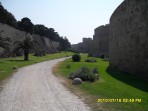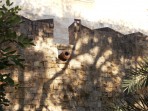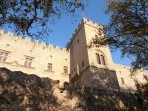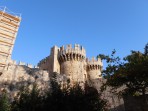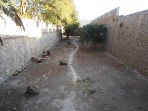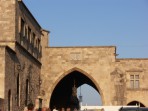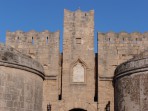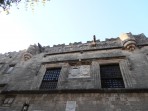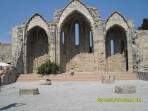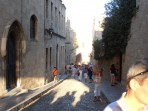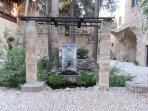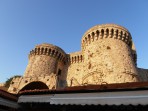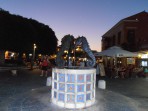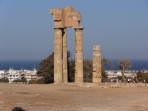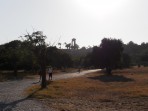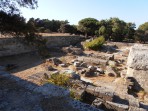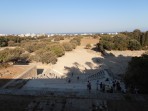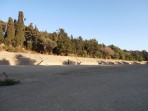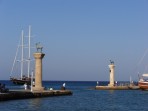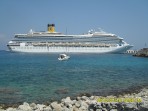Rhodes Capital City - Rhodes island
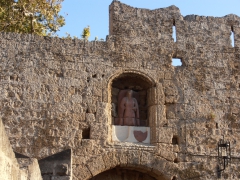
The capital city of Rhodes is a wonderful historic town with a large number of beautiful monuments from different stages of its long and interesting history. These monuments are in very good condition and thanks to the local people the ancient buildings are coming back to life and especially at night Rhodes is a very lively and vibrant place. The capital city of Rhodes lies on the northern tip of the island.

History of Rhodes Town
Rhodes dates back to 408 BC and has been the capital of the island of Rhodes since its foundation. Since then, the city has undergone a long evolution that has left indelible traces on its appearance, and today we can admire many beautiful historical monuments, for example, both ancient buildings and monuments from the time of the Knights of St. John (Johannites).
Many of the surviving buildings were built by the Knights of St John and during their reign they managed to make the city one of the strongest fortifications in Europe. However, the Johanites were forced to leave in 1522, when the city was conquered by the Turks under Sultan Suleyman. The local Greeks began to build new houses of their own outside the boundaries of the original Knights' Town (where the so-called New Town is today).
The capital of Rhodes can thus be divided into two parts - the Old Town, full of original buildings and monuments, and the New Town, a modern city with hotels and shopping malls. The Old Town has been a protected monument since 1960 and has maintained a permanent place on the UNESCO World Heritage List since 1988. Today Rhodes has a population of more than 50,000 and is also the administrative seat of Dodecanese.
Rhodes Old Town and Historical Sites
The city of Rhodes is still protected by double massive walls, between which there is a deep moat, but it has never been filled with water. The width of the walls is an incredible 12 metres. The total length of the city walls reaches 4 km and you would gradually discover seven entrance gates and several towers and round bastions. These well-preserved remains of the medieval fortifications already make a great impression on visitors, but it is only beyond them that the real historical core - the Old Town - awaits.
The construction of Rhodes was based on the project of Hippodamus of Miletus, which was based on a rectangular street system. To this day, some streets bear famous Greek names, such as Homer's, Hippodamus', Socrates', Pythagoras', Pericles', etc.
In Symi Square you can find the remains of the ancient temple of Aphrodite from the 3rd century BC, then you can stop by the marble fountain in Argirokastrou Square or take a stroll along the reconstructed ancient Knights' Street (Odos Ippoton), boasting Gothic buildings with magnificent gardens that were founded in the 14th to 16th centuries.
On the highest point in the north-western part of the city stands the Palace of the Grand Masters, the residence of the highest knight of the Johannite Order, built in the early 14th century. The Palace was subsequently reconstructed by the Italians in 1940 after it was destroyed by a gunpowder explosion in the mid-19th century. The building stands out above all for its imposing entrance and beautiful towers and battlements. The interiors of the buildings are equally impressive, beautifully decorated and partially open to the public. In the courtyard of the palace stands a bronze statue of the she-wolf who, according to legend, raised Romulus and Remus. The statue of the she-wolf originally protected the access to the Mandraki harbour, but was later moved to the palace.
The Archaeological Museum in the old Knights' Hospital is also a popular destination for tourists and houses, among other things, the sarcophagus of Grandmaster Comeillian. While walking around the city, you might also visit the Square of the Martyrs (Platía Evreon Martiron) or the Square of Hippocrates.
Even the Turks who ruled the island in the 16th century left their mark on the city. Most of the monuments from this period, the domes and mosques, can be found in the so-called Turkish Quarter of the Old Town. The most sought-after place in the Turkish Quarter is the Suleyman Mosque, next to which stands the Clock Tower with its regularly playing chimes. And if you still have the energy, you can climb up the tower and enjoy the view from its height. Mention should also be made of the Turkish Library, which preserves unique Turkish and Persian manuscripts, especially two rare manuscripts of the Koran. To this day, this part of the city is still inhabited by the Turkish community, but unfortunately most of the mosques are in a poor state of decay. However, you can visit the many bazaars and shops run by the locals.
If you go to Rhodes on an organised excursion, your guide may also take you to Monte Smith, which towers over the town. The Acropolis of Rhodes is located here, with the remains of the magnificent ancient Temple of Apollo, archaeologically partially restored. It is said that the temple was destroyed in the same powerful earthquake as the Colossus of Rhodes. Beneath the temple lies the amphitheatre, which still enchants visitors with its acoustics. If you have the courage, try to stand in the centre of it and make a speech. Nearby is the ancient stadium, which is still used for festive sporting occasions.
New Town Rhodes
The New Town of Rhodes, which lies north of the Old Town, is all about entertainment and shopping, with a large number of shops, restaurants, bars, Greek taverns and entertainment venues. In the centre of the town there is the so-called Bar Street, where nightlife lovers will find their favour.
But also in the New Town you will find historic houses, important monuments or museums, for example. At the northern tip of the island is the marine aquarium, which was built by the Italians in the 1930s. A small natural history museum is attached to the aquarium, where you can see the most famous animals of the Mediterranean. When visiting the capital of Rhodes, you can also visit the National Theatre.
Rhodes coast - Mandraki port and beaches
Nowadays, Rhodes has three ports. The old port of Mandraki is the most famous for tourism, as it is here that the majestic Colossus of Rhodes, one of the Seven Wonders of the Ancient World, is said to have stood. The huge bronze statue of the sun god Helios was cast around 300 BC. According to surviving sources, it was over 30 metres high and placed on a stone base. The Colossus of Rhodes was such a unique structure in its time that the medieval Greeks and Franks even called the inhabitants of the island Colossians. However, the statue did not remain a landmark of the wealthy island city for long, for in 225 BC a great earthquake struck the area and the Colossus of Rhodes and its pedestal collapsed.
Today the harbour is decorated with two bronze statues of a stag and a rope, which have become the modern emblem of the city. Nearby on the pier stands the fortress of Agios Nikolaos (St. Nicholas), functioning as a lighthouse, and three old windmills. Near the harbour, the so-called New Market (Nea Agora) is still in use and the entrance to the city gates is located here.
The port of Mandraki is currently used mainly for yachts and small cruise ships. Commercial ships mainly use the port of Emborió Limani.
If you want to take some time to relax and cool off in the sea, the long, pebbly beach of Ixia stretches along the north-west coast. From the tip of the island towards the southeast, the beautiful Eli beach is connected to it, with tavernas, shops, rentals, hairdressers, etc. At the northernmost tip of the island, the Aegean and Mediterranean seas meet. You can then boast of having swum from one sea to the other. In the distance, about 30 km away, on the horizon of the sea, you can see the Turkish mainland looming.
Why visit the capital of Rhodes?
If you're looking to explore Greek history on your holiday, stroll among the ancient monuments and enjoy the nightlife after sunset, then Rhodes is for you. However, we recommend that you make a full day of your visit, as there is so much to see here. The "Rhodes by night" is also an interesting tip for a trip, as under artificial lighting and with the darkness at your back, the ancient buildings take on a different, mysterious air.
Plus a few travel tips at the end. You can't get directly to the Old Town by car. If you're lucky, you'll find a free space in the paid parking lot by the harbor, otherwise you'll have to park further away from the center or use the bus service. There are buses to the capital from almost every resort on the island, so you don't have to worry about parking. The streets in the town are quite narrow, but traffic is not completely excluded - you may see cars and scooters of locals and contractors. A degree of caution is in order. The city streets are not only narrow but also quite convoluted. We therefore recommend you have a map of the capital with you. It will make it easier to find your way around and you can at least mark the places you want to see on it. On the other hand, even with a map you can easily lose your bearings, because there are about 200 streets and alleys in the city that simply don't have names. There is also a tourist train tour in Rhodes. The train will take you for less than an hour and its route focuses mainly on the ancient monuments - the stadium, the amphitheatre, the Temple of Apollo.
More touristic destinations of Rhodes
Tips for trips on Rhodes: Lindos White Town, Rhodes Capital, Kalithea Spa, Symi Island and Panormitis Monastery, Seven Springs (Eptá Pigés), Valley of the Butterflies (Petaloudes), Faliraki Water Park
Resorts, beaches, sights or trips - clearly listed on the map of Rhodes.
Did you visit this place and do you have some additional informations, interessting observation or photos?

